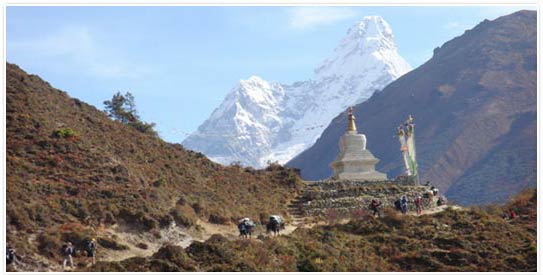|
Navavarsha (Nepali New Year) (Apr - May)
Nepal has its official calendar that begins from the first day
of the first month Baishak. It is known as "Navavarsha"
in Nepal. This very first day is observed as Nepali New Year which
usually falls in the first/second week of April. People go for picnics,
have get-togethers and celebrate the day socializing in various
ways as this day is also a national holiday.
Bisket Jatra (Apr - May)
"Bisyau" jatra meaning the festival celebrated in the memory of
slaying of serpents. In the passage of time the term changed from
‘Bisyau’ to Bisket jatra. The festival is celebrated
at Bhaktapur, a medieval town from 12th century, still maintained
in the same manner and only 13km East of Kathmandu.
Since the Bisket begins in the last days of the Nepalese year and
ends in the beginning days of the New Year it is regarded as the
New year festival as well. During the seven days of the festival
chariots of God. Bhairava and Goddess Bhadrakali are pulled with
lot of merriment within the town limits. At a place called Lyasinkhel
a lyasin or a tall pole is erected with two long embroidered cloths
hanging from it. These cloths represent two evil serpents who in
the past had troubled the royal family by mysteriouly killing every
suitor to the princess at night. Ultimately a brave prince with
the blessings of Goddess Bhadrakali came along and killed them even
as they appeared from the nostrils of the sleeping princess and
began to enlarge themselves. Thus, to show the townspeople the cause
of previuos suitors' death they were hung from the pole and at present
the cloths represent them.
Buddha Jayanti (Apr - May)
Buddha's birth anniversary is celebrated every year during full
moon day of May in Nepal. On this day people swarm in Swayambhunath,
Boudhanath and Patan to pay homage to Lord Buddha and also visit
Buddha's birth place in Lumbini and chant prayers and burn butter
lamps. Lord Buddha was born as Prince Siddhartha Gautam but he abandoned
his luxurious life when he realized the misery of mankind and went
in search of enlightenment.
Red Machhendranath Rath Jatra (Apr - May)
This festival is the biggest socio - cultural event of Patan. The
wheeled chariot of deity known as Bungdyo or Red Machhendranath
is made at Pulchowk and dragged through the city of Patan is several
stages till in reaches the appointed destination. The grand finale
of the festival is called the Bhoto Dekhaune or the showing of a
vest” A similar kind of chariot festival to Machhendranath
is also held in Kathmandu city in the month of March April.
The Teechi (May)
The Teechi (also pronounced "Teji") festival is an annual
event indigenous to Lo-Manthang (Upper Mustang). The name is an
abbreviation of the word "Tempa Chirim" which translates
as "Prayer for World Peace". This festival commemorates
the victory of Lord Buddha's incarnation "Dorjee Sonnu"
over a demon called Man Tam Ru, a vicious creature feeding on human
beings and causing storms and droughts.
The Teeji festival usually takes place during
the last week of May and last for 3 days. Dances performed by the
monks of Lo Manthang's and choedhe' monastery during the celebration
display. The harassment of Ma Tam Ru Ta (in a dance called Tsa Chham
on the first day), the birth of Dorjee Sonnu s the demon's son (on
the second day called Nga Chham), theattempt to return the demon
to lord Buddha's realm (on the third and final day). The Teeji festival
dances are all organized by the Choedhe Monastery, which is that
of the Shakya sect of Lo Manthang.
Dumji (July)
It is celebrated in all the Sherpa settlements in the month of
July. The Sherpa of Kathmandu and Helambu regions participate in
dancing on this day.
Gunla Festival Nepal (July - Aug)
Following the arrival of the monsoons and the planting season in
the fields, Buddhists in the Kathmandu Valley observe the Gunla
festival. The month long event celebrates a 'rains retreat' initiated
25 centuries ago by the Buddha.
Gunla is a time for prayer, fasting, meditation and religious music.
Worshippers climb past jungles, stone animals, great statues of
Buddha and begging monkeys to the hilltop at Swayambhu where daily
prayers begin before dawn. Oil lamps, prayer flags, religious statues
and paintings adorn the monasteries whilst temple bells chime and
powerful incense fills the air. Important statues are put on display
and the teachings of Lord Buddha are remembered as the rains feed
the rice crop.
Janai Purnima & Raksha Bandhan (July - Aug)
On Janai Purnima, when the moon is full
in August, high caste Hindus chant the powerful Gayatri mantra and
change their Sacred Thread (or janai) while a red or yellow protection
chord (a rakshya bandhan) is tied around the wrists of other Hindus
and Buddhists. Many pilgrims journey to the mountains north of Kathmandu
to emulate Lord Shiva by bathing in the sacred lake of Gosaikunda.
Those unable to make the trek north, celebrate at Shiva's Kumbheshwor
Mahadev temple. Here a pool with an image of Shiva at its centre
is filled with water believed to have come from Gosaikunda.
| Festivals in the month of |
|
|
|


